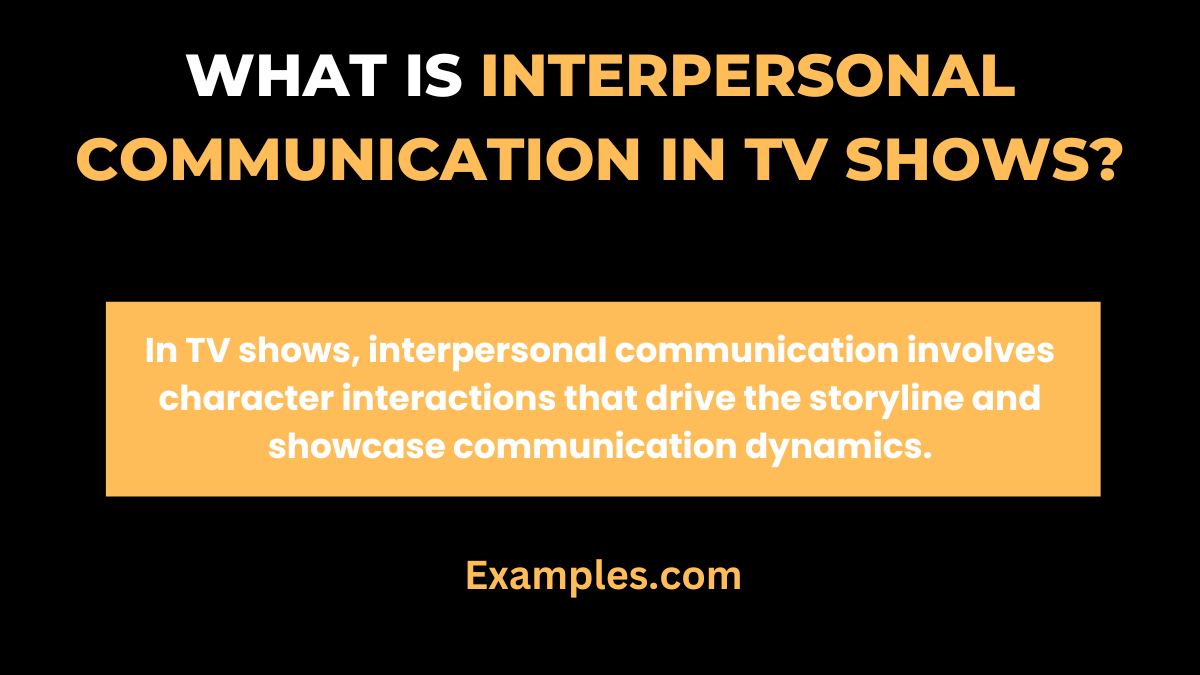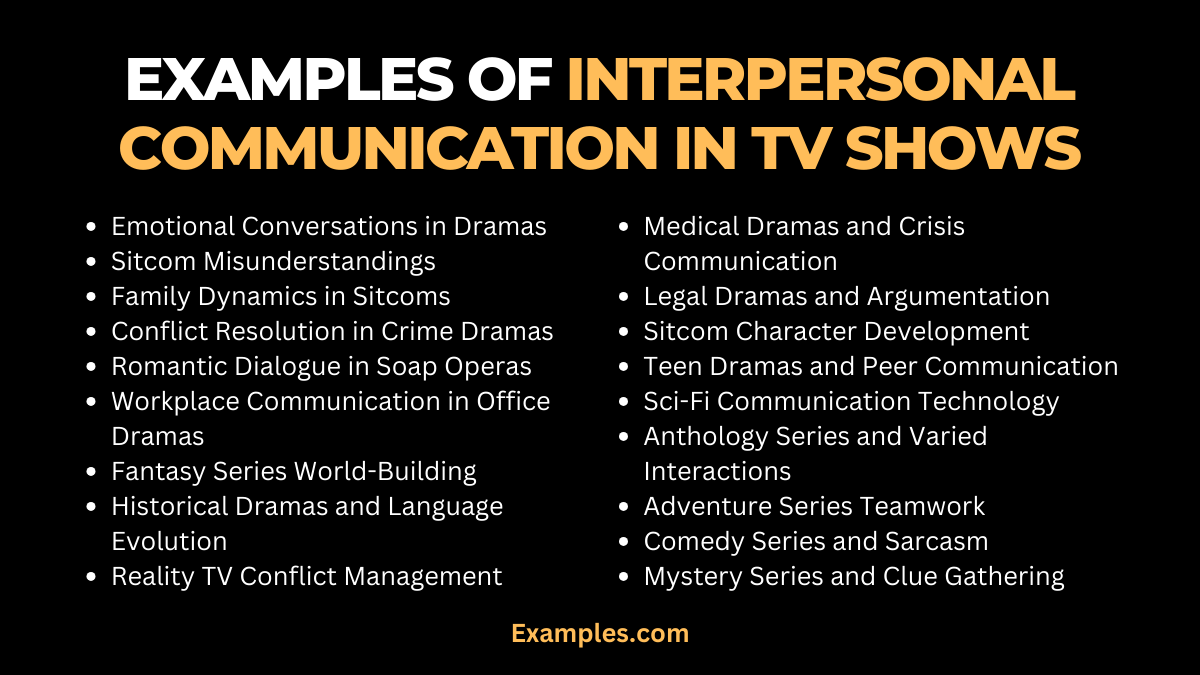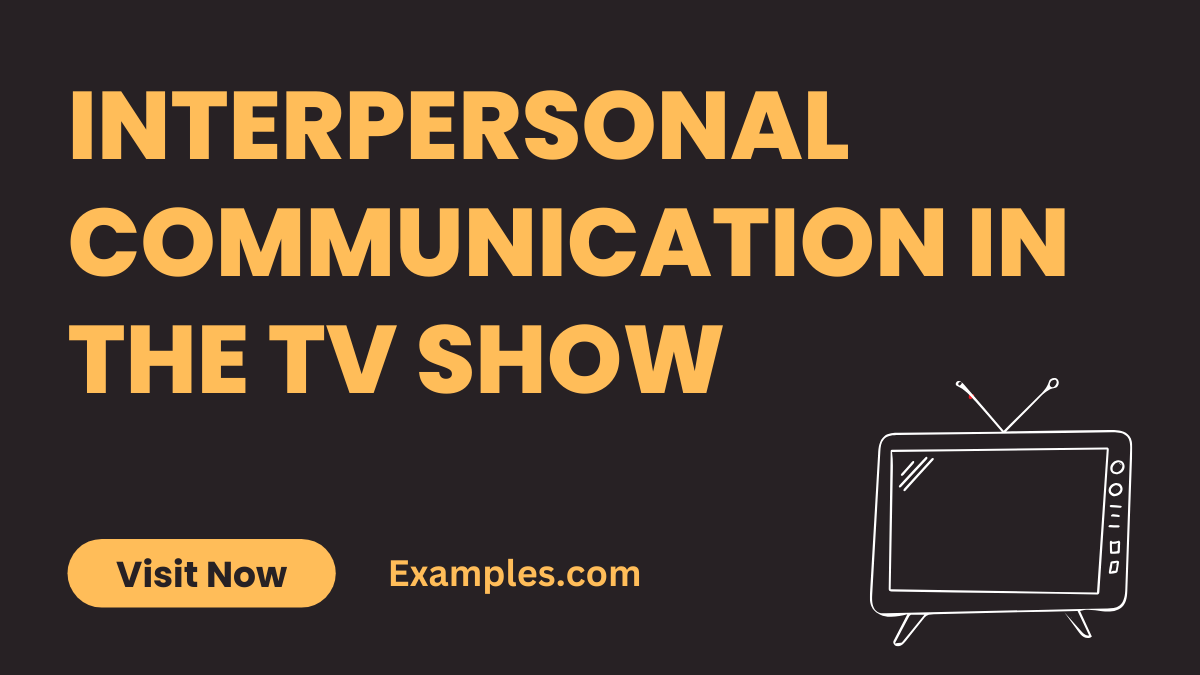29+ Interpersonal Communication in Tv Shows Examples
Interpersonal communication in TV shows provides a fascinating window into human interactions. These shows often use communication examples to depict complex relationships, conflicts, and resolutions. From dramatic confrontations to heartfelt conversations, TV characters demonstrate a range of communication styles and techniques. This guide delves into various scenarios from popular TV shows, highlighting key lessons in effective communication. Whether it’s a tense negotiation, a romantic dialogue, or a family dispute, each example offers unique insights into the art of interpersonal communication.
What is Interpersonal Communication in Tv Shows?

Interpersonal communication in TV shows refers to the way characters interact with each other. These interactions can range from casual conversations to intense emotional exchanges, and they play a key role in developing the storyline and characters. Through these on-screen communications, viewers can observe and learn various aspects of verbal and non-verbal communication, conflict resolution, and relationship dynamics.
30 Examples of Interpersonal Communication in Tv Shows

- Emotional Conversations in Dramas: Dramatic TV shows often depict intense emotional exchanges that showcase empathy, conflict, and resolution.
Example: “In a heartfelt scene, the character expresses deep regret, using tone and body language to convey sincerity.” - Sitcom Misunderstandings: Sitcoms frequently use misunderstandings to create humor, demonstrating the importance of clear communication.
Example: “A character misinterprets a friend’s comment, leading to a comedic situation that highlights communication breakdowns.” - Family Dynamics in Sitcoms: Family-oriented sitcoms showcase diverse communication styles within a family, from authoritative to nurturing.
Example: “A parent uses a firm yet caring tone to guide their child, balancing authority with empathy.”

- Conflict Resolution in Crime Dramas: Crime dramas often feature characters resolving conflicts through negotiation and strategic communication.
Example: “Detectives use careful questioning and active listening to resolve a tense standoff.” - Romantic Dialogue in Soap Operas: Soap operas are known for their expressive romantic dialogues, highlighting emotional expression and vulnerability.
Example: “In a moment of passion, characters share their feelings openly, showcasing effective emotional communication.” - Workplace Communication in Office Dramas: Office-based dramas depict professional communication, from formal meetings to office politics.
Example: “A manager addresses her team with clarity and confidence, setting clear objectives.” - Fantasy Series World-Building: Fantasy shows often involve creating unique communication styles to define different cultures and worlds.
Example: “Characters in a fantasy realm use a distinct dialect, emphasizing cultural differences in communication.” - Historical Dramas and Language Evolution: Historical dramas provide insight into how communication styles and language have evolved over time.
Example: “Period-specific dialogue in a historical drama reflects the communication norms of that era.” - Reality TV Conflict Management: Reality TV often features real-life conflict resolution, demonstrating various interpersonal communication strategies.
Example: “Contestants navigate misunderstandings and tensions, using compromise and empathy.” - Medical Dramas and Crisis Communication: These shows depict high-stakes communication in medical emergencies, emphasizing clarity under pressure.
Example: “Doctors communicate urgently yet clearly during a medical crisis, ensuring team coordination.” - Legal Dramas and Argumentation: Legal dramas showcase the art of argumentation and persuasive communication in courtrooms.
Example: “Lawyers articulate their points with precision and persuasion in court scenes.” - Sitcom Character Development: Through seasons, sitcoms show character growth, often reflected in how they communicate and relate to others.
Example: “A character evolves from shy to confident, reflected in their more assertive communication.” - Teen Dramas and Peer Communication: These shows explore how teenagers communicate with peers, addressing topics like bullying and friendship.
Example: “Teen characters navigate peer pressure and friendships, learning to express themselves authentically.” - Sci-Fi Communication Technology: Sci-fi TV shows often introduce advanced communication technologies, exploring their impact on society.
Example: “Futuristic devices in sci-fi series represent advanced forms of digital communication.” - Anthology Series and Varied Interactions: Each episode of an anthology series presents different characters and communication challenges.
Example: “A character in an anthology series faces a unique moral dilemma, requiring critical communication.” - Adventure Series Teamwork: Adventure series often focus on teamwork, highlighting the importance of clear and effective communication among team members.
Example: “In a challenging situation, the team coordinates using concise and direct instructions.” - Comedy Series and Sarcasm: Comedies use sarcasm and wit to explore the subtleties and complexities of interpersonal communication.
Example: “Characters in a comedy series often use sarcasm to add humor to their conversations, while still conveying their message.” - Mystery Series and Clue Gathering: Mystery shows demonstrate how detectives gather clues through careful questioning and observation.
Example: “The detective uses targeted questions and keen observation to unravel the mystery, showcasing effective interrogative communication.” - Reality Show Alliances: Reality shows often feature contestants forming alliances, requiring discreet and strategic communication.
Example: “Contestants whisper and use non-verbal cues to form alliances without alerting others.” - Children’s Shows and Simple Communication: Children’s programming uses simple, clear language to teach and entertain, demonstrating the basics of effective communication.
Example: “Characters in children’s shows use simple, direct language and repetition to ensure comprehension.” - Talk Shows and Interview Skills: Talk shows provide examples of excellent interview techniques, including active listening and engaging questioning.
Example: “The host uses open-ended questions and active listening to draw out interesting stories from guests.” - Cooking Shows and Instructional Communication: Cooking shows are great examples of clear, step-by-step instructional communication.
Example: “Chefs on cooking shows explain recipes in a clear, step-by-step manner, making complex tasks easy to understand.”

- Game Shows and Quick Decision Making: Game shows often require contestants to communicate decisions quickly and clearly under pressure.
Example: “Contestants shout out answers or discuss options rapidly, demonstrating quick, decisive communication.” - Sports Commentary and Descriptive Communication: Sports commentators provide real-time, descriptive communication, painting a vivid picture of the action for viewers.
Example: “Commentators use vivid, descriptive language to bring live sports action to life for the audience.” - Soap Operas and Emotional Exchanges: These shows are known for their dramatic, emotional communication, often revolving around relationships and family dynamics.
Example: “Characters in soap operas engage in intense, emotional dialogues, demonstrating the power of expressive communication.” - Documentaries and Informative Communication: Documentaries provide factual information in an engaging and accessible way, often involving interviews and narration.
Example: “Narrators in documentaries use clear, engaging language to convey complex information.” - Animated Shows and Creative Expression: Animation allows for creative and imaginative forms of communication, often using visual and verbal humor.
Example: “Animated characters often communicate in exaggerated, humorous ways that combine visual and verbal cues.” - Teen Sitcoms and Social Interaction: These shows often revolve around high school life, addressing how teenagers communicate and interact socially.
Example: “Teen sitcoms depict characters navigating social dynamics at school, highlighting various forms of peer communication.” - Historical Mini-Series and Period Communication: These series offer insights into the communication styles of different historical periods.
- Example: “Characters in historical mini-series use period-appropriate language and etiquette, providing a window into past communication styles.”
Importance of Interpersonal Communication in TV Shows
- Character Development: Interpersonal communication is crucial in depicting the depth and evolution of characters. Dialogues and interactions reveal their personalities, motivations, and changes over time.
- Plot Progression: Effective communication between characters drives the narrative forward, creating engaging and dynamic storylines.
- Viewer Engagement: Realistic and relatable communication keeps viewers emotionally invested, enhancing their connection to the characters and the show.
- Conflict Resolution: The way characters communicate in conflict situations often serves as a pivotal moment in resolving key plot points.
- Cultural Representation: TV shows use interpersonal communication to represent and explore different cultures, fostering a broader understanding among audiences.
- Social Issues Depiction: Many shows address social issues through the conversations between characters, providing a platform for awareness and discussion.
- Humor and Entertainment: Witty and humorous exchanges add entertainment value, making the show more enjoyable for audiences.
- Educational Value: Shows with accurate and thoughtful communication can serve as educational tools, especially in genres like family drama or educational programming.
- Building Suspense: Strategic communication, or lack thereof, can build suspense and intrigue, keeping viewers hooked.
- Reflecting Social Dynamics: How characters interact reflects the social dynamics of the setting, providing insight into relationships, hierarchies, and societal norms.
Concepts Of Interpersonal Communication In The TV Show
- Verbal vs. Non-Verbal Communication: Shows often contrast what characters say with their body language, revealing true feelings or intentions.
- Active Listening: Characters who listen actively often become key mediators or problem-solvers within the plot.
- Perception and Interpretation: How characters perceive and interpret each other’s communication often leads to plot twists or misunderstandings.
- Emotional Expression: Emotional vulnerability or expression in dialogues often leads to pivotal moments in character relationships.
- Communication Styles: Different characters’ communication styles, whether assertive, passive, or aggressive, play a role in their interactions and relationships.
- Public Speaking: Characters in leadership or influential roles often demonstrate public speaking, influencing plot direction and other characters.
- Persuasion Techniques: Characters use persuasion in various scenarios, from simple domestic arguments to major plot negotiations.
- Cultural Communication Differences: Shows set in diverse environments highlight how cultural differences affect communication styles and understanding.
- Digital Communication: The use of digital communication, like texting or social media, reflects modern interpersonal dynamics.
- Communication Barriers: Language barriers, disabilities, or other communication challenges faced by characters add depth to the narrative.
Role of Interpersonal Communication in TV Shows
- Relationship Dynamics: Communication is key to developing and exploring relationships between characters, from romantic to familial or professional.
- Character Motivation: Dialogues often reveal the motivations and backstory of a character, adding layers to the narrative.
- Mood Setting: The tone and style of communication can set the mood of a scene, from tense to comedic.
- Symbolism and Themes: Metaphorical language and nuanced dialogues often convey deeper themes and symbolism in the plot.
- Empathy Creation: Effective communication between characters can evoke empathy in viewers, aligning them with the characters’ journeys.
- Social Commentary: Through character interactions, shows often comment on societal norms, issues, and trends.
- Conflict Creation and Resolution: Communication is often the source of conflict as well as its resolution within the storyline.
- Audience Understanding: Clear and effective communication helps the audience understand complex plotlines and character actions.
- Genre Definition: The style of communication can help define the genre of the show, from drama to comedy.
- Character Contrast: Differences in communication styles can be used to contrast characters, highlighting their differences and complementarities.
In conclusion, this guide illuminates the diverse landscapes of interpersonal communication in TV shows, offering insights into how these dynamics play out in various genres. From sitcoms to reality shows and cooking programs, it highlights the integral role of communication in shaping narratives and character interactions. These tips and examples serve as a valuable lens for understanding and appreciating the complex communication strategies employed in television.



